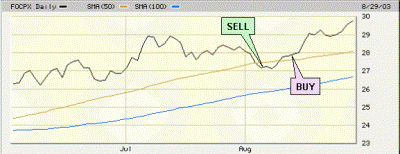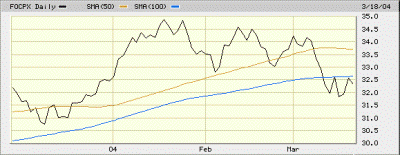Market Timing Part 2
I posted my first entry on market timing last May. The market had bottomed out and was on the rise and I wanted to a way to stay out of future declines while still being invested during rallies. Market timing seemed to be a way to do that and I decided to play around with it in my deferred compensation account which allows me to get in and out of my mutual funds without paying capital gains taxes or incurring sales charges. I was going to do it with only Fidelity Over-the-Counter (ticker: FOCPX, 20% of my portfolio) but decided to apply to my others as well including Vanguard Index 500 (VIIIX, 60%), American EuroPacific Growth (AEPGX, 10%), and Ariel Fund (ARGFX, 10%). I would use the 50-day moving average. When the current price drops below the 50-day moving average you sell. When it goes back above the 50-day moving average you buy it back. You can refer back to my original posting to see how well this can work.
But the theory and the reality are a little different. First, you don't get to sell right when the price goes below the 50-day average. You have to wait for the fund to close below the average (unless you try to anticipate the closing price; more on that later) and then buy it the next day (if the market doesn't rise enough to get back above the 50-day average). The problem is the price line moves the most on days with big losses or gains so often you end up well below the 50-day average. Here's my first cycle of Buy and Sell:

As you can see I waited for the price to go below the 50-day average (the brown line) and sold the next day when the market actually moved up a tiny notch. That was August 5 and I sold 165 shares for $27.18. For the next couple of days the market didn't do much but then it started going back up, crossing the line just a few days later, indicating time to buy. I didn't want for the price to dip right back below the line again so I waited a couple of days and bought back my shares at $27.94. I bought the shares back at a higher price than I sold them so essentially I missed out on $125.40 of gains which to me is like a loss of 2.8%. That's okay because that is fairly cheap insurance and even Merriman says you will lose out more often than you gain, but the big trends will make up for it. Still, the 50-day average moved much less than 2.8% in those days (maybe $0.20 per share or 0.7%), so the theoretical looked a lot better than the actuality. So it turns out that every time you buy and sell on a blip like this, you will probably lose a couple of percent.
The market continued to rise and I was fully invested so at least I wasn't missing out on the continuation of the rally. There was time in late September that I almost had to sell but the price stayed just above the 50-day average and the rally continued again. Then in late November it started going down again. The bull market had sent this fund up around 30% so I was worried that we were due for a correction. On October 24 the previous closing price was above the line but in the afternoon the market indexes (Nasdaq for FOCPX) were showing a loss that would push the price below the 50-day average. I anticipated and sold that day. A small end of the day rally made the loss not quite as bad as it had been earlier in the day and the closing price fell right on the 50-day average.

The next day the market went back up. Afraid of a false rally I stayed on the sidelines for another day or two before finally realizing I needed to be back in. So I wound up selling 180 shares for $30.55 and buying them back at $31.48. This time I missed out on a 3% rise, or $167.40. Combined with the earlier blip I had lost out on about 5% of a 30% rally.
Really, I should have bought my shares back the very next day, but that seemed so inefficient. I do worry that if I jump in an out too often that my deferred comp plan will cut me off or change their policies. Interestingly, at about this time the Department of Justice started investigating some mutual fund companies who were allowing certain large clients to do market timing, jumping in an out of funds like I was doing. Many of the funds had rules against allowing small investors doing this. The effects of big moves on a mutual fund company is they have to keep cash on hand or buy and sell shares more often, hurting their overall performance (which is divided out among all shareholders, even the ones who have bought and are holding like you're supposed to).
The market continued to be kind of volatile as it seemed to be reaching some upward resistance and I wound up selling again in November after the price dropped below the indicator again, selling 164 shares at $30.87 on November 17. Again the market soon went back up but I figured the rally was about out of gas and decided not to buy back the shares. I felt like the timing thing is a good indicator, but you also have to trust your own comfort levels and I felt more comfortable keeping that 20% of my portfolio on the sidelines for the time being (plus I wasn't thrilled with FOCPX in general).
The next graph shows what happened afterwards up until today. My intuition was correct and the market dipped back below the 50-day average again just a week or two later. Then it went back below again. I had a good chance to buy my shares back at close to the average around December 20, but felt it would go back below the average for good. Well, it didn't. Instead it went up like a rocket all the way up past $34 a share, 10% more tacked onto the rally.

Merriman says it takes discipline to do market timing and stick to it. I can see what he means. I didn't want to do too many Buy-Sell loops because I was losing a few percent every time. Also it is worth noting that Merriman recommended using the 100-day moving average as an indicator which was never crossed until March 2004. So that would have kept me invested the whole time, avoiding my 2% and 3% missed opportunities and my big one when I gave up on timing for a little while.
At the same time this was going on, I was also doing timing with my other mutual funds with similar results. With VIIIX I lost 3.8% and 1.1%, but ultimately stayed invested until recently when it dipped below the 50-day again. With ARGFX I lost 2% and 1% and am still invested now though I probably am below the 50-day average right now. And finally with AEPGX I only had one buy-sell cycle where I missed out on 3% and sold recently.
My conclusions so far: I think it is still worth following. One of the advantages of timing is that it reduces volatility. That means your investments don't fluctuate in value as much, a positive thing. If you could invest in a fund making 10% per year with very little volatility vs. one making 10% and is all over the map, you'd want with lower volatility.
Also you have to be very strict about following the strategy, even if it means you sell one day and buy the next for 1 or 2 percent more. It's painful to do this when the price is crossing over the indicator often so it still takes some intuition. I could try the 100-day indicator but I still feel like you miss a lot of smaller trends with the longer period.
See a follow-up entry.
Comments (1)
With "Market Timing" and "Capitalization" this sounds like Ted Financial News. (Even though Capitalization in this case isn't about anything financial.
Market Timing is too complicated for me. I don't want to think that much.
If I had followed by own rule... sell when you make 35%, I would have gotten out of Martha the Friday before the verdict when rumors of an innocent verdict caused her to jump from 12 to 17. But I got greedy and had a standing order to sell at 18.
I think you should go w/ the 100 day average so you can think less.
Posted by Bruthu J | March 21, 2004 7:08 PM